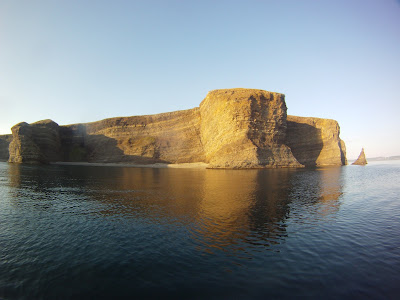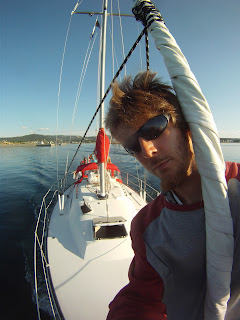St. John's is very much a working harbour. The only provision for cruising boats is a floating wooden pontoon attached by a wobbly gangway to the edge of the harbourside park.
The harbour authority man who welcomed us told us with a cheery smile that there was no water, no electricity, no toilets or showers, and no other facilities whatsoever.
Fortunately, we were saved from thirst, hunger and uncleanliness by Ken Ryan, the ex-commodore of the Royal Newfoundland Yacht Club, who came down to see what boats were in. Ken and his wife Carol welcomed us into their immaculate and spacious home, which is full of beautiful pictures of yachts of various shapes and sizes. The following night, Ken and Carol drove us over to the yacht club - half an hour's drive or a day's sail away in Conception Bay on the other side of the peninsula.
Out in the bay we explored the beautiful rock formations of Bell Island, and dined like royalty aboard Ken and Carol's yacht, Relentless, while the sun set.
 |
| Bell Island and Clapper Rock |
The coastline back on the St. John's side is just as rugged, or perhaps even more so.
This landscape culminates in Signal Hill to the north of the harbour, which has a varied military history. It was also the site of the first successful reception of a radio signal across the Atlantic in 1901, by the radio pioneer Guglielmo Marconi.
There are a good many people in St. John's who, if you give them a grin and a minute or two, will relate the most extraordinary stories of local history and folklore. A self-described "homeless Canadian bum" who I met up Signal Hill told me about many things: the seal-hunters walking miles out to sea on the winter ice; the American bomber found frozen into the top of an iceberg that washed up in a nearby bay a few years ago (it had crashed in Greenland in 1942 and taken this long for the ice to work its way down to the sea and across the ocean to Newfoundland); and the fact that the Smithsonian Institute chose this area to study the condition known as SAD: Seasonal Affective Disorder - since the winters here are so cold and depressing.
Another guy I met near our mooring pointed to a metallic appendage sticking out of a nearby building, and after I confessed I had no idea what it could be, he said "think submarine". It was, he said, a periscope taken from a German U-Boat that had been captured during the war.
 |
| The periscope atop the building across the road |
Nowadays, the town, like the fireworks, is booming - thanks to a handful of oil rigs offshore on the Grand Banks of the North Western Atlantic. The oil rig supply boats constantly coming and going from the dock next to where we are moored have loud engines that echo through the water directly into Taniwha's hull, meaning that we have an almost constant stereophonic remider that we are just an insignificant group of small pleasure-seekers in amongst the titans of heavy industry.













1 comment:
Hi Mark,
we have just been reading the blog.
What an adventure & love your photos and comments.
Taniwha is a tad bigger than Seaspoon !
Have a safe and exciting final leg
to Falmouth.
love from us both,
Ivor & Liz
Post a Comment